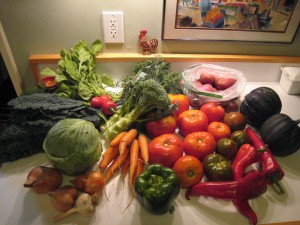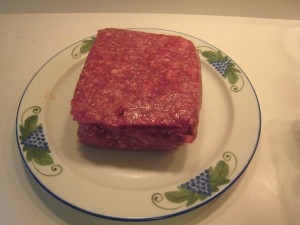Category:Food Science’
What’s So Bad About HFCS?
- by KitchenPantryScientist
Move over, red meat. High Fructose Corn Syrup (HFCS) is the new bad boy of the food industry. Although companies like Hunt’s, Gatorade and Pepsi are rushing to replace HFCS with sugar, it’s ubiquitous in our nation’s food supply. Not only was there a recent report of mercury contamination in HFCS, but in February, a study came out of Princeton University suggesting that rats fed HFCS for 6 months gained more weight, had more body fat and showed higher triglycerides than rats fed the same amount of table sugar (sucrose.) A flurry of debate, fueled in part by the corn syrup industry, followed, calling into question the significance and accuracy of the study. In the meantime, Michael Pollan’s book “The Omnivore’s Dilemma,” and films like “Food Inc.” and “King Corn” accuse the corn industry of practically force-feeding Americans corn products.
I’ve been skeptical about all the negative press that High Fructose Corn Syrup is getting. As I recall from my biochemistry class, all sugars are broken down into their simplest forms so the body can use them for energy. They can be used immediately, or stored for later use either as fat, or as a carbohydrate called glycogen.
Reading more, I learned that sucrose, and HFCS are both composed of two simple sugars: glucose and fructose. Both contain about 50% glucose and 50% fructose. The big difference is that the fructose molecules in HFCS float free, while each fructose molecule in sucrose is stuck tightly to a glucose molecule.
The Princeton researchers think the unbound fructose in HFCS is more likely to be stored as fat than the bound fructose molecules in sucrose. They may be on to something.
It makes sense that sucrose and HFCS would be processed, or metabolized, differently. Our body has to do some work to break apart the glucose and fructose in sugar, while the fructose in HFCS is instantly available to our metabolic machinery. For thousands of years, our bodies have evolved to break down plants, whole grains and meat to power our cells. Now, we’re essentially shoveling pure energy down our throats in the form of HFCS, white flour and other processed foods. I don’t think it will be long before researchers have more concrete evidence that corn syrup is not equivalent to sugar in the human diet.
I’m not going to knock myself out avoiding foods containing HFCS, but as a mom and a label reader, I will definately choose products sweetened with sugar. Call it a gut feeling.
Under Pressure: Antibiotics and Adaptation
- by KitchenPantryScientist
For centuries, people have harvested corn by hacking it off, six to fifteen inches above the ground. A caterpillar called the corn borer appears to have adapted its behavior to the corn harvest by travelling back down the stalk to a safe height, before spinning its cocoon. This week, the Science Times reported on a study that suggests that, by descending to the bottom of the stalks, the bugs avoid being chopped off when the corn is harvested. Researchers at McGill University think that “over generations, those caterpillars that did not descend, or did not go down far enough, did not survive.” In the article, Dr. Calcagno suggests that the likeliest explanation for this behavior is the selection pressure of harvesting over generations. In other words, only the caterpillars that crawled down survived to reproduce and make baby bugs, until only caterpillars with the family trait of crawling down remained in the population.
Similar forces are at work on bacteria that live in animals and humans, only instead adapting to harvest, they’re adapting to constant exposure to antibiotics. As a result, many harmful bacteria are finding ways to “outsmart” antibiotics. This is, in part, due to the mind-boggling volume of these drugs fed to animals produced for food. I can’t give you a number, because according to the Center for Disease Control’s website, the amount of antibiotics fed to farm animals is not available to the public or to government agencies.
Feeding animals antibiotics helps them grow. No one knows exactly why. Unfortunately, using these drugs as growth enhancers, or even to protect them from disease, often creates antibiotic-resistant strains of bacteria that have the potential to end up in our food supply. These drug-resistant pathogens are especially dangerous to people who live and work on farms ( just ask Russ Kremer, who was gored by one of his hogs and nearly died from an antibiotic-resistant infection.) In reponse to the global threat presented by antibiotic resistance, the World Health Organization recommended that antibiotics used in humans should not be used to promote growth in food animals.
Healthy animals occasionally need to be treated for infections, but feeding animals antibiotics for growth benefits is a risk no one should be taking. A huge amount of money is spent each year on these drugs so producers can get top dollar for their animals. My worry is that the additional costs to public health are not being considered, especially if our pharmaceutical arsenal is rendered useless by this practice.
Want to learn more? You can check out the CDC’s website for a wealth of information on antibiotic resistance. Their program “Get Smart on the Farm” promotes appropriate antibiotic use in animals.
FRESH
- by KitchenPantryScientist
 Happy Earth Day! This weekend, we planted a garden. Few things make me happier than watching my kids digging in the dirt, planting things. Maybe it’s because I come from a long line of farmers, or maybe it’s the sun-warmed, homegrown tomato I can almost taste just by thinking about it.
Happy Earth Day! This weekend, we planted a garden. Few things make me happier than watching my kids digging in the dirt, planting things. Maybe it’s because I come from a long line of farmers, or maybe it’s the sun-warmed, homegrown tomato I can almost taste just by thinking about it.
One of the most interesting books I’ve read recently is Michael Pollan’s “Omnivore’s Dilemma,” which follows four meals from field to table (from McDonald’s to foraging for mushrooms and hunting a wild boar.) It reminds the reader of how disconnected we have become from the sources of our food. One of my favorite parts of the book talks about Joel Saletin, who is a seminal figure in the sustainable agriculture movement and probably the most famous farmer in America. His bio on the FRESH movie website says:
“Joel calls himself a grass-farmer, for it is the grass that transforms the sun into energy that his animals can then feed on. By closely observing nature, Joel created a rotational grazing system that not only allows the land to heal but also allows the animals to behave the way the were meant to – as in expressing their “chicken-ness” or “pig-ness”, as Joel would say.”
This week, Joel is in town with Ana Joanes, who has made a documentary called “FRESH” that celebrates the farmers, thinkers and business people across America who are re-inventing our food system. It’s about food, but it’s also about economics, community and social justice. Last weekend, I was lucky enough to meet both Ana and Joel while volunteering at one of Joel’s lectures and was impressed with their optimism and sense of humor. Ana recently told planetgreen.discovery.com “I just had a little girl. Her name is Maayan. And, as clichéd as it may sound, I just want to do right by her. I don’t know what reality she’ll face when she reaches adulthood, but I’m trying my best so she doesn’t have to pick up the pieces of our recklessness and inaction.”
I saw FRESH last night in Minneapolis and loved it! The movie is just 70 minutes long, but you will want to talk about it for two hours afterwards! Tonight’s the last night it’s showing, so if you’re in the Twin Cities, don’t miss it! You can order tickets here.
The movie brings up interesting points about monocultures, antibiotic resistance, high fructose corn syrup, the corn industry (which my grandparents’ farm in Iowa is a part of,) and beneficial bacteria. I’m planning to explore many of these issues on this blog by writing a weekly post about food science between science experiments! Stay tuned!
Words That Made a Difference
- by KitchenPantryScientist
Congratulations to Michael Moss, of the New York Times, for winning a 2010 Pulitzer Prize for his expose “The Burger That Shattered Her Life.” According to the New York Times, his reporting on the ground beef industry “led the Agriculture Department to review it’s safety procedures and a major slaughterhouse and food retailer to agree for the first time to test raw ingredients that would go into ground beef.”
I remember reading his work and being shocked to learn that many ground beef producers wouldn’t sell to retailers who wanted to retest their meat for E. Coli contamination. The system still isn’t perfect (see my post on ground beef additives,) but at least someone is listening.
Diet vs. Supplements
- by KitchenPantryScientist

In today’s Science Times, Jane Brody tells us that it what we eat, rather than the supplements we take, that can help us live longer, healthier lives. She claims that eating a mostly plant-based diet with plenty of good fats (i.e. the Mediterranean diet), along with plenty of exercise, seems to be the key to lowering your risk of several types of disease. Read the article at http://www.nytimes.com/2010/01/12/health/12brod.html?ref=science . (Even if you’re not vitamin-takers, it is important to make sure that you and your family get plenty of calcium and vitamin D, through supplements if necessary, and keep in mind that you should always follow your pediatrician’s recommendations.)
Singing about Hydrogenated Oils
- by KitchenPantryScientist

When I’m not busy with my kids or blogging, one of my favorite things to do is sing with my neighborhood garage/party band, ” The 952″. Recently, I got the chance to perform for a bigger audience when “I Can’t Believe it’s Not Butter!” sent my fellow blogger and good friend unplannedcooking.com a Flip video camera. They asked her to create and film a commercial for their new “Turn the Tub Around” campaign, advertising their new, healthier product which does not contain any hydrogenated oils* and is therefore trans-fat free.
Jennifer let me in on the fun, and with the help of a few friends, we managed to juggle our kids and our schedules just long enough to put a video together. Not only did we sing for the video, we had to learn a signature dance move (and I am NOT a great dancer.) Incredibly, we just found out that our video is a finalist in the video contest. We’re up against some very talented competition, but there’s a chance that part of our homespun video might air on a commercial during American Idol next Tuesday, Jan.12th. You will be able to view our video beginning on Jan.19th on the “Watch, Vote and Win Sweepstakes” at www.turnthetubaround.com. Check it out for a glimpse of a couple of moms acting like kids! You’ll also have a chance to win great prizes every time you vote for your favorite video! Hopefully, it will be ours.
Now for the science. Here’s your biochemistry lesson for the day: There are four kinds of fats: monounsaturated fat, polyunsaturated fat, saturated fat, and trans fat. Monounsaturated fat and polyunsaturated fat are considered to be the “good” fats in the human diet (think olive oil.) It is generally accepted that consumption of saturated fat should be kept low, especially for adults. Trans fat (which means trans fatty acids) is the considered the least healthy type of fat, far worse than saturated fat. Partial hydrogenation is an industrial process used to make vegetable oils, like soybean oil, into a less healthy product containing transfats. The process is used to make an oil more solid; provide longer shelf-life in baked products; provide longer fry-life for cooking oils, and provide a certain kind of texture or “mouthfeel.” The problem is that partially hydrogenated vegetable oil is laden with trans fat, which has been linked to health problems. In fact, there are currently several campains calling for the ban of partially hydrogenated oils. You, of course, have to decide what is best for you and your family. If you’re curious, there is much more specific information online about the health effects of transfats.
Note: The free video Flip camera was sent in exchange for our participation in the contest and I LOVE it! It’s small enough to fit in my purse and plugs right into my USB port to download videos.
Dog Food Anyone?
- by KitchenPantryScientist
First of all, I have nothing against real ground beef. That is, I will eat beef that has been ground by my local butcher or trusted grocer. I love a good burger.
However, starting today, I refuse to eat ground beef from an unknown source (i.e. fast food restaurants and big chain grocery stores.) Not only does the ground beef industry refuse to allow retesting of their meat (they won’t even sell it to stores who retest it,) I just read that one company is taking parts of cow that are considered unusable, treating the beef “trash” with ammonia gas to kill harmful bacteria that tend to contaminate those cow parts, and selling it to be mixed with higher quality ground beef to make it cheaper for restaurants and schools (yes, schools!) This disgusting meat product, which doesn’t list ammonia as an ingredient, although it remains following treatment, may still harbor dangerous bacteria. It’s unbelievable.
I’m not touching ground beef from an unknown source or letting my kids eat it until the beef industry and the U.S.D.A get their act together. I’d suggest you do the same. Maybe if we all boycott their substandard, potentially dangerous product, they’ll stop trying trying to feed us beef products that used to be made into dog food.
For a more complete story, read today’s New York Times article at http://www.nytimes.com/2009/12/31/us/31meat.html?_r=1&hp




